When most of us think of conservation, we think of remote, wild places. In the United States, the National Park system often represents this ideal. Elsewhere, iconic landscapes like the Serengeti in Tanzania or the rainforests of the Amazon and southeast Asia come to mind. For over a century, the conservation model has been dominated by protected areas and the belief that setting aside land for nature, then limiting human impact and use as much as possible, was the best way to protect it.
This has been a remarkable global undertaking, and in some respects, a success – there are just over 238,000 protected areas across 244 countries and territories.[1] That is almost 15% of the land on Earth.[2]
However, the limits of a “top-down” protected area model are becoming clear. Biodiversity continues to plummet. The history of protected areas creation is littered with examples of local communities being removed from their traditional lands and banned from activities they depend on for their livelihoods, such as hunting or gathering medicinal plants. And places suitable for new protected areas are becoming scarce.
An alternative model, community-led conservation, offers a way to address these problems. It’s a conservation tool that trusts that local people know how to be good stewards when they have the resources and tools to do so. Community-led conservation often relies on traditional or indigenous knowledge of the landscape, and new research shows it can be equally as effective as conservation approaches that exclude people from nature completely, sometimes more so.
What is community-led conservation?
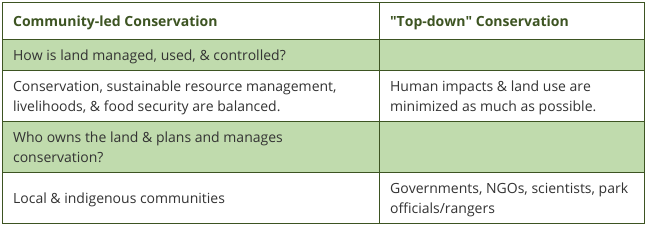
Community-led conservation, also known as “working lands” conservation, is when local or indigenous peoples sustainably manage a landscape to support both nature and people. In other words, they manage the land to produce food, fuel, timber, and other products, while maintaining habitat for wildlife. This style of management also sustains nutrient and water cycles, as well as ecosystem services such as pollination and carbon sequestration.[3] In this vision, conservation does not have to come at the cost of communities’ presence on the land or their livelihoods.
Community-led conservation also emphasizes the critical role of managing landscapes to complement protected areas, a principle known as “habitat connectivity.”[4] Sustainable working landscapes can act as bridges between natural areas, allowing species to move across much larger landscapes than is currently possible in our world of isolated protected areas. Maintaining physical connections between habitats, and making sure they are truly usable for species, is one of the most important things we can do to support biodiversity.
Why is community-led conservation important?
Community-led conservation has been shown, in some cases, to be more effective in the long-term for conserving carbon, biodiversity, and natural resources than projects that don’t allow active landscape management.
Biodiversity-friendly land management is an ancient practice.[5] Despite this, much protected area conservation is based on the assumption that human presence on a landscape is harmful. Studies are increasingly finding that this is not necessarily true, especially in the case of forests. Indigenous and local stewardship protects forests – not to mention all the life, natural resources, and carbon stores they contain.
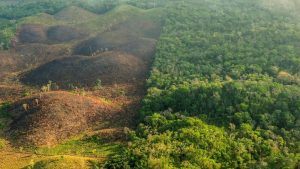
For example, when the Maya Biosphere Reserve in Guatemala was established in 1990, conservationists were outraged that the government was going to allow community-led management on one fifth of the Reserve, and some refused outright to engage with communities.[6] But thirty years later, it’s clear that these communities have protected their land far more effectively from deforestation and other illegal activities than a top-down, no-resource-use-allowed model would have done. Deforestation in community-managed areas of the Reserve has been less than 1% since 2005. Meanwhile the deforestation rate is 20 times higher in areas outside their control. [7]
In Brazil, the Apiwtxa Asháninka indigenous people established a new territorial outpost in 1992 to better protect their boundaries. Community monitoring has caught and successfully expelled illegal hunters, loggers, and farmers. The Apiwtxa Asháninka have since developed community guidelines on how to interact with outsiders and manage natural resources.[8]
Research by the World Resources Institute and the Rights and Resources Initiative (of which Forest Trends is a founding partner), among others, has shown that deforestation tends to be lower in forests where communities have secure tenure rights and are protecting their land.[9],[10],[11],[12] Forest Trends has made similar observations in the areas we have worked in the Amazon.
Studies are also increasingly showing that community-led conservation can more effectively protect land than government measures over the long term, which can also make it less expensive to maintain than 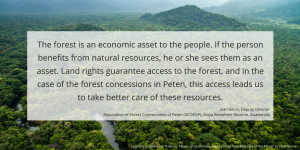 traditional protected areas.[13]
traditional protected areas.[13]
Overall, less deforestation means less associated carbon emissions and less habitat loss and fragmentation – all of which are essential to biodiversity conservation, battling climate change, and meeting global commitments, like the Paris Agreement or the UN’s Sustainable Development Goals.
Community-led conservation allows forest benefits to be harvested by communities and countries.
In the Amazon, sustainable forest management not only preserves carbon and biodiversity, it can also support livelihoods. Small-scale enterprises like agroforestry, sustainable timber, artisanal handcrafts, and producing non-timber forest products, like acai, Brazil nuts, or cocoa, allow communities to generate income and ensure food security for themselves.
The planning, management, and monitoring required for these activities also leads to more frequent land patrols, which ultimately increases territorial protection.[14] Forest Trends has supported communities with such efforts for over two decades and has observed first-hand the power and wide-ranging benefits of small investments in community-led forest enterprises.[15] For example, our partnerships with indigenous communities scaling up Brazil nut value chains are already yielding benefits for both indigenous producers and Amazon forests. Increasing Brazil nut production requires mapping existing nut trees and opening new harvesting sites, which, in turn, provides resources for the bigger picture: helping communities patrol their lands for illegal incursions by speculators, cattle ranchers, loggers, and miners.
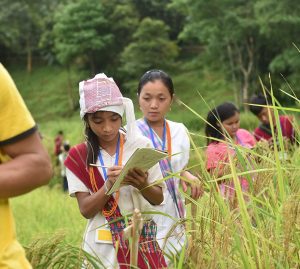
Securing livelihoods and economic development on their own terms helps communities prevent the poverty often associated with displacement from their lands and abandonment of traditional practices. Karen peoples in Myanmar have been displaced by armed conflict for a generation, denied autonomy, and forced to flee violence. In 2018, they returned to a portion of their ancestral lands and established the Salween Peace Park. Within the Peace Park, the Karen have revived traditional governance systems, reintroduced agroforestry, and formed a committee to monitor their boundaries. The Park protects one of the region’s most important remaining biodiversity hotspots.[16]
Examples like this shed light on the possibility for community-led conservation to also be an investment in human rights, and a solution that aligns the priorities of human well-being, sustainable development, and preventing ecosystem loss.[17]
That being said, consulting indigenous peoples and local communities during a conservation project as stakeholders is not enough – the world needs to recognize their land rights and rights to engage in decisions that affect their homes. This is a critical step towards fulfilling the respect, recognition, and reciprocation these 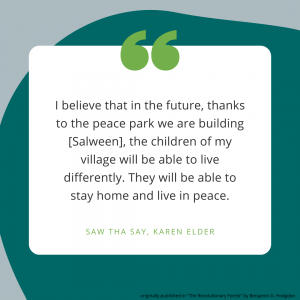 communities are owed for the benefits they provide by managing and protecting traditional lands, such as carbon sequestration, avoided deforestation, cleaner and more reliable water supplies, and biodiversity conservation. All of these community-provided services cross borders, benefitting people in other regions and countries.[18],[19] Benefits such as these are incentive for continued long-term stewardship, and demonstrated successes help make a strong case for formalized support and recognition.
communities are owed for the benefits they provide by managing and protecting traditional lands, such as carbon sequestration, avoided deforestation, cleaner and more reliable water supplies, and biodiversity conservation. All of these community-provided services cross borders, benefitting people in other regions and countries.[18],[19] Benefits such as these are incentive for continued long-term stewardship, and demonstrated successes help make a strong case for formalized support and recognition.
Community-led conservation complements and expands upon other conservation efforts to reverse biodiversity loss.
Protected areas have become increasingly isolated as surrounding lands are degraded and converted for other uses. Without natural buffer areas that connect patches of habitat, species cannot migrate (or disperse, in the case of plants) freely or safely as a natural part of their life cycle, or to escape negative impacts of human activity or climate change.[20] Research also suggests that protected areas will continue to lose species over time if they become isolated from each other.[21]
Simply put, the world will have to stop relying on protected areas to achieve conservation goals because there are not enough suitable places left to put them. Protected areas alone are not sufficient to save species over the long-term, and as already noted, they can override the rights and well-being of rural communities.[22]
Part of the solution is local stewardship: a patchwork of protected areas connected by biodiversity-friendly, multi-use landscapes that enable species to move freely.[23] For example, landowners in the Caesar River Valley in Colombia planted native species on exhausted farmland, which has helped connect patches of forest, restore soil health, provide habitat for wildlife, help buffer against climate-induced economic losses, and allowed cattle to be more sustainably managed on less land.[24] Forest communities on the Maya Biosphere Reserve in Guatemala have observed the return of wildlife that need large home ranges to thrive, such as jaguars and their prey.[25]
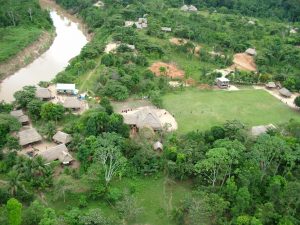
What’s more, the broad coalitions necessary to launch and support community-led conservation have greater potential to create a collective impact. This has been central to how Forest Trends has operated for 20 years – by acting as coalition builders, we have observed many lasting partnerships and successes on the ground, especially in our work with indigenous and local communities. Collaborations between these communities, grassroots movements, NGOs, and sometimes public-private partners are more adaptable and better equipped to demand changes and drive lasting transformations, especially at government levels.[26]
In Ucayali, Peru, the Korinbari Community, with early support from Forest Trends, developed a territorial monitoring system to detect and halt illegal fishing, hunting, and logging. This led to legal repercussions for 20 people who had been illegally encroaching on their lands. It didn’t end there, either – the community mobilized with the support of regional indigenous organizations and brought prosecutors from the state to force out outsiders. The community is currently fundraising to expand this important control and vigilance system.
In another example in Nepal, collaborative support and investment from forest community organizations, public-private donors, and NGOs helped community-led forest management become legalized by the national government in 1993. As of 2017, 2.9 million households were participating in over 22,000 community forests.[27]
[Download Infographic]
[1] UNEP-WCMC. 2018. 2018 United Nations List of Protected Areas. Supplement on protected area management effectiveness. UNEP-WCMC: Cambridge, UK. www.sprep.org/attachments/VirLib/Global/2018-list-protected-areas.pdf.
[2] Protected Planet. “Aichi Target 11 Dashboard.” Protected Planet, data from UNEP-WCMC & IUCN, updated monthly. Accessed on 29 Sept. 2020. www.protectedplanet.net/target-11-dashboard.
[3] Kremen, C. and Merenlender, A.M. 2018. Landscapes that work for biodiversity and people. Science. 362, 6412. doi: 10.1126/science.aau6020.
[4] Note: While marine and aquatic environments are not discussed in this piece, connectivity is also critical to the conservation of these systems.
[5] Kremen, C. and Merenlender, A.M. 2018. Landscapes that work for biodiversity and people. Science. 362, 6412. doi: 10.1126/science.aau6020.
[6] Pearce, Fred. June 18, 2020. “Parks vs. People”: In Guatemala, Communities Take Best Care of the Forest.” Yale Environment 360, Yale School of the Environment. e360.yale.edu/features/parks-vs-people-in-guatemala-communities-take-best-care-of-the-forest.
[7] de Ferrer, Marta. Feb. 9, 2020. “How has 30 years of logging saved the rainforest in Guatemala?” euronews. www.euronews.com/living/2020/08/30/how-has-thirty-years-of-logging-saved-the-rainforest-in-guatemala.
[8] Zwick, Steve and Calderon, Ciro. 23 Sept. 2016. “The Asháninka People Of The Amazon Are Saving The Forest, And Doing It Their Way.” Ecosystem Marketplace. www.ecosystemmarketplace.com/articles/ashaninka-people-amazon-saving-forest-way/.
[9] Walker, W.S., et al. 2020. The role of forest conversion, degradation, and disturbance in the carbon dynamics of Amazon indigenous territories and protected areas. PNAS. 6, 3015-3025. doi: 10.1073/pnas.1913321117.
[10] Baragwanath, K. and Bayi, E. 2020. Collective property rights reduce deforestation in the Brazilian Amazon. PNAS. 34, 20495-20502. doi: 10.1073/pnas.1917874117.
[11] Rights and Resources Institute, et al. 2018. A Global Baseline of Carbon Storage in Collective Lands. Washington, D.C.: Rights and Resources Institute. rightsandresources.org/en/publication/globalcarbonbaseline2018/#.X1JZAZNKhBx.
[12] Seymour, F., La Vina, T., and Hite, K. 2014. Evidence linking community-level tenure and forest condition: An annotated bibliography. San Francisco: Climate and Land Use Alliance. www.climateandlandusealliance.org/wp-content/uploads/2015/08/Community_level_tenure_and_forest_condition_bibliography.pdf.
[13] Sources: footnotes 8-11 above
[14] Borges, B. and Olander, J. April 26, 2020. “The “Amazon Strategy” – How to Build Resilient Supply Chains and Food Systems post-Pandemic.” Forest Trends. www.forest-trends.org/blog/the-amazon-strategy/.
[15] Forest Trends. July 30, 2020. Two Decades Partnering with Indigenous Communities. Washington, D.C.: Forest Trends. www.forest-trends.org/publications/two-decades-partnering-with-indigenous-communities/.
[16] Hodgdon, Benjamin D. Spring 2020. “The Revolutionary Forest.” Earth Island Journal. www.earthisland.org/journal/index.php/magazine/entry/the-revolutionary-forest-myanmar-peace-park/.
[17] Erbaugh, J.T., et al. 2020. Global forest restoration and the importance of prioritizing local communities. Nature Ecology & Evolution. Brief Communication. doi: 10.1038/s41559-020-01282-2.
[18] Rights and Resources Institute, et al. 2018. A Global Baseline of Carbon Storage in Collective Lands. Washington, D.C.: Rights and Resources Institute. rightsandresources.org/en/publication/globalcarbonbaseline2018/#.X1JZAZNKhBx.
[19] van Dam, Chris. 2020. The Economics of Climate Change Mitigation in Indigenous Territories. Forest Trends. www.forest-trends.org/publications/the-economics-of-climate-change-mitigation-in-indigenous-territories/.
[20] Kremen, C. and Merenlender, A.M. 2018. Landscapes that work for biodiversity and people. Science. 362, 6412. doi: 10.1126/science.aau6020.
[21] J. M. Halley, N. Monokrousos, A. D. Mazaris, W. D. Newmark, D. Vokou, Dynamics of extinction debt across five taxonomic groups. Nat. Commun. 7, 12283 (2016). 10.1038/ncomms12283pmid:27452815.
[22] Erbaugh, J.T., et al. 2020. Global forest restoration and the importance of prioritizing local communities. Nature Ecology & Evolution. Brief Communication. doi: 10.1038/s41559-020-01282-2.
[23] Kremen, C. and Merenlender, A.M. 2018. Landscapes that work for biodiversity and people. Science. 362, 6412. doi: 10.1126/science.aau6020.
[24] ibid
[25] Pearce, Fred. June 18, 2020. “Parks vs. People”: In Guatemala, Communities Take Best Care of the Forest.” Yale Environment 360, Yale School of the Environment. e360.yale.edu/features/parks-vs-people-in-guatemala-communities-take-best-care-of-the-forest.
[26] Gnych, S., et al. 2020. Investing in commonly-held resources for inclusive and sustainable development: Lessons from Guatemala, Mexico, Nepal, and Namibia. Jawa Barat, Indonesia: Center for International Forestry Research (CIFOR). doi: 10.17528/cifor/007499.
[27] ibid
Viewpoints showcases expert analysis and commentary from the Forest Trends team.
Connect with us on Facebook and Twitter to follow our latest work.
